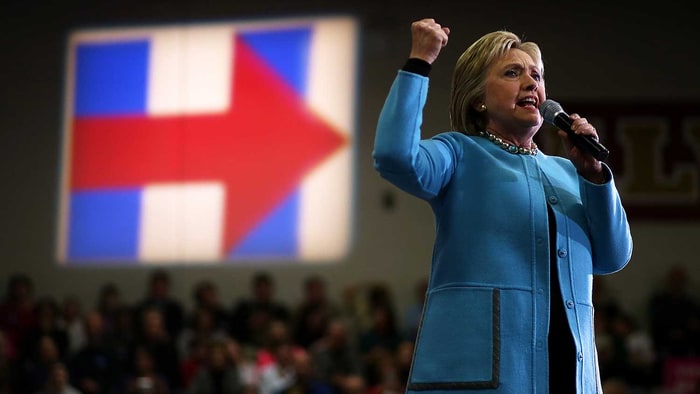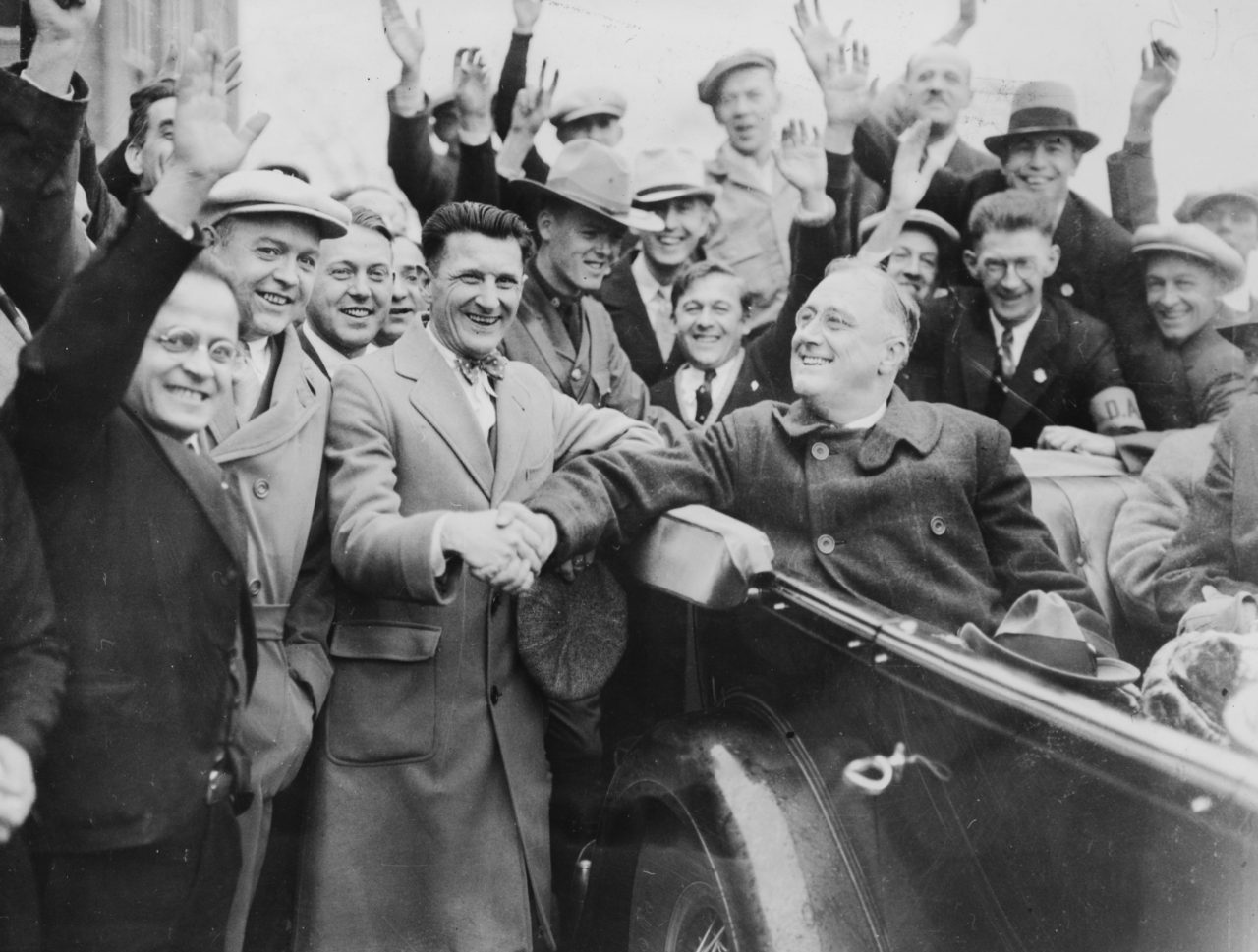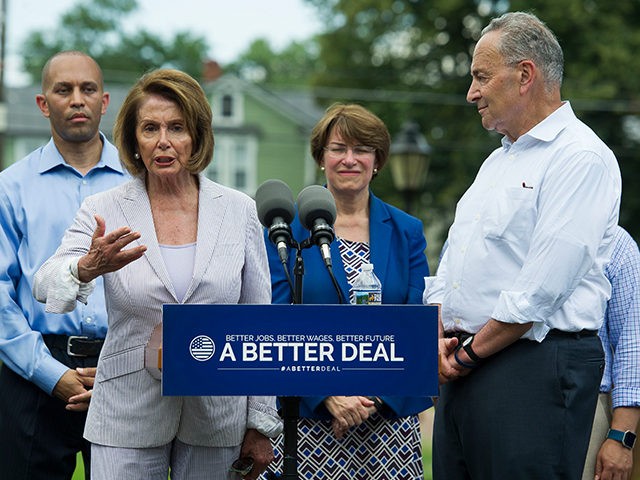I. Elections Have Consequences
Monday’s headline in The Washington Post teased the new rollout: “Democrats plan to announce their 2018 campaign agenda from a ruby-red corner of Northern Virginia.” Yes, top Democrats would be assembling in the little town of Berryville to pitch their new platform, which they have dubbed “A Better Deal.”
That same day, on the op-ed page of The New York Times, the Democratic Senate Minority Leader, Charles Schumer, laid out three key points:
First, we’re going to increase people’s pay. Second, we’re going to reduce their everyday expenses. And third, we’re going to provide workers with the tools they need for the 21st-century economy.
If anyone doubts that elections have consequences, here are some consequences—for the Democrats. President Trump may be facing frustration in advancing his Republican agenda, but he has clearly succeeded in changing the Democrats’ agenda.
Just last year, Democrats were campaigning on such ideological exotica as co-ed school bathrooms, “implicit bias training” for the police, and unquestioning support for radical groups like Black Lives Matter.
Then, something happened: The Democrats lost. Indeed, as everyone knows, after the 2016 election, the Democrats were at their lowest ebb in nearly a century.
Thus we can see: Barack Obama’s aloof style of two-tier politics—simultaneous playing to both suite-dwelling plutocrats such as George Soros and street-marching demagogues such as Al Sharpton, while ignoring the middle—didn’t work out so well. For the Democrats, Obama proved to be the opposite of a political messiah; he was a millstone.
To be sure, Obama is still very much on the political scene, and yet since he is term-limited out of the presidency, the Democrats don’t have to worry about him steering their party into any more electoral icebergs.
Yet the same can’t be said for Hillary Clinton; she can run again, and many observers think that she would love to seek the White House in 2020, if only she could find a way.
Indeed, Hillary’s fundraising base is so huge—she raised at least $1.2 billion last time, double the amount of Trump—that she could still hold out hope for another run. She might further be thinking to herself that if other oldsters, such as Joe Biden and Bernie Sanders, can toy with another bid, then, by golly, so can she.
Of course, Hillary is in her own special category—the category of bad candidate. As in her other losing campaign, back in 2008, she seems to be permanently surrounded by a coterie of costly consultants, adding little or no value, but always finagling the next paycheck.
For instance, her 2016 campaign featured the off-puttingly self-referential slogan, “I’m with her.” Translated: The campaign was not about ordinary people and their interests, but, rather, it was the voters’ chance finally to do right by Hillary by electing a woman—her—as president. (The national majority took a pass on that opportunity.)
In addition, there was that famous Hillary Clinton logo–you remember, the one with a blue “H” and a red arrow running to the right, which told people, in effect, “think red and move right.” And so they did.

Justin Sullivan/Getty Images
We might step back and marvel at how many committees, and how millions of dollars, could be devoted to producing such fiascos. In search of an explanation, one can only fall back on the common-sense wisdom: The actual proves the possible. Clinton did those dumb things, and that’s why she lost.
For these and many other reasons—here’s looking at you, Huma!—Schumer seems determined to make sure that Clinton’s White House ambitions, finally, are blocked. He was bluntly dismissive of her on Saturday, recalling last year’s election to The Washington Post:
When you lose to somebody who has 40 percent popularity, you don’t blame other things—Comey, Russia—you blame yourself.
To be sure, it’s by no means certain that Clinton will get the message so easily, and perhaps Schumer, the strongest Democrat in the country today, will have to administer the anti-Hillary medicine many more times. If so, few observers doubt that he will do whatever it takes to get her out of the presidential picture, because the Democrats really, really, want to be winners, and they can’t do that with proven losers.
Yet at the same time, Schumer realizes that Democrats need to do more than just clear away the deadwood. That is, Schumer & Co. have learned, the hard way, that you can’t beat something with nothing.
Thus the senior senator from New York asked, and answered, a key question about last year’s results:
So what did we do wrong? People didn’t know what we stood for, just that we were against Trump. And still believe that.
Schumer was no doubt thinking of a buzzy July 15 Washington Post/ABC News poll, which found that just 37 percent of Americans think that the Democrats stand for important issues, while a much larger number, 52 percent, believe that they simply stand against Trump.
II. The Better Deal Echoes Past Democratic Success—They Hope!
The Better Deal document seeks to change that policy message-lessness, even as it represents a distinct shift in politics—Trump’s name isn’t mentioned even once.
The Democrats now insist that they do, in fact, have a bold policy agenda, heavy on economic populism, including an increased minimum wage, toughened trade-law enforcement, energized anti-trust scrutiny, and renewed emphasis on combating high pharmaceutical drug prices.
The immediate goal is to retake the House next year. In fact, Rep. Cheri Bustos (D-IL), one of the key architects of the new Better Deal messaging plan, was candid as to the Democrats’ motivation—winning. As she told The Washington Post, “We have to figure out this heartland messaging if we’re going to get to 218 members of Congress by 2018.”
We can observe that Democrats seem to like number-play, and sometimes it works for them. Back in 2006, they used the phrase “Six in ’06” to describe their campaign agenda in that year’s midterm elections. And it worked: the Democrats won big that year, scoring a net gain of six Senate seats, 31 House seats—enough to recapture control of both chambers from the Republicans—as well as a half-dozen governorships. (We might recall that the chairman of the Democrats’ senatorial campaign unit that year was the same Chuck Schumer.)
Here we might pause to note that one great strength of the two-party system is that it makes the cost of losing totally and inescapably clear. That is, the outcome is binary: a party is either in, or out. By contrast, in a multi-party system—such as those found in most European parliamentary systems—being a losing party sometimes isn’t so bad, because there’s always the possibility of being a junior member of a power-sharing coalition. Or, failing that, at least losing parties have the comfort of knowing that there are other losing parties, too—misery loves company.
So now today, here in the two-party USA, Democrats have been reminded what it’s like to be out—and they don’t like it.
Thus we come to the mega-question of the 2017-18 election cycle: Will the Better Deal stratagem actually work? Will it make the voters forget Obama, Clinton, and the other motley ’16 characters?
Not surprisingly, not every Democrat likes the new tagline. Tommy Vietor, a spokesman for Obama’s National Security Council, tweeted:
Please God someone tell me this is not real. This is the shittiest slogan I have ever seen. Fire the consultant who created it right now. https://t.co/mrwtJONdss
— Tommy Vietor (@TVietor08) July 20, 2017
To be sure, Vietor might have good reason to reject the new message out of hand, because, as we have seen, it’s a sharp repudiation of his old boss, the 44th president.
Moreover, Schumer has gone out of his way to make that anti-Obama point, however obliquely. In his Times op-ed, he admitted:
For far too long, government has gone along, tilting the economic playing field in favor of the wealthy and powerful while putting new burdens on the backs of hard-working Americans.
We can immediately observe that the words “for far too long” would seem to extend further back than January 20, 2017, when Trump took office. In other words, Schumer is blaming the previous president, as well as other Democrats.
Indeed, he made that point even more plain in the very next paragraph:
Democrats have too often hesitated from taking on those misguided policies directly and unflinchingly—so much so that many Americans don’t know what we stand for. Not after today. Democrats will show the country that we’re the party on the side of working people.
We might also note that Schumer himself was elected to the House in 1980, and to the Senate in 1998. During all those years, he was hardly known as a renegade. So if Schumer is criticizing the Democratic Party for letting the middle class down, he, too, deserves criticism.
And yet he seems willing to own his share of the blame, even as he seeks to change the game: Once again, the Democrats really, really want to win.
Indeed, after going 0 for 4 in the contested special House elections this year, Democrats are resolved to do more than stage pink hat-style #Resistance rallies. They are looking instead for #Lunchbucket issues that can help them, they hope, reach the Silent Majority.
As Bustos also said, in her visits back home to her Northwest Illinois district—which voted strongly for Trump last year—“Not one has brought up Russia to me, not one has brought up impeachment.”
Interestingly, she was joined in that assessment by another Democrat who worked on the Better Deal plan, Rep. Hakeem Jeffries of New York. Jeffries represents mostly minority Brooklyn, and yet he echoed Bustos’ kitchen-table concerns; his voters, too, are focused on “pocketbook issues, housing challenges, crime, public safety, failures of the public schools.”
Thus we can see: The Democrats must pose as practical problem-solvers, not as true-believing ideologues. As Schumer himself said of the new Democratic agenda:
It’s not about moving the party left or right, and it’s not about appealing to one coalition or another. A strong, sharp-edged, populist, bold economic message appeals to the Obama coalition and the people who voted for Trump — former Democrats who voted for Trump.
Of course, some might wonder if the Democrats have really turned the page, abandoning their familiar left-wing cultural menu in favor of economic centrism.
III. The Sincerity Tests: Immigration and Infrastructure
One skeptic is Fred Siegel, an academic and think-tanker—back in 2005 he wrote a well-received biography of Rudy Giuliani—who happens to live in Jeffries’ Brooklyn district. “Identity politics isn’t like a toolbox that can be put away in the garage,” Siegel argues. That is, the Democrats can’t simply switch off the lefty stuff, because it’s who they truly are. He continues:
The minor leagues [the feeder system] of both Democratic Party politics and America’s media and cultural politics—that is, the colleges and universities— are pervaded by identity politics. That won’t end anytime soon.
Siegel makes a good point, and yet at the same time, it’s possible that the Schumerian Democrats could flood the system with their new messaging. For instance, on Sunday, Schumer said that Democrats are “open to” the idea of single-payer national health insurance.
Without a doubt, that’s a controversial position, well to the left of where either the Clinton or Obama administrations ever were on healthcare. And yet today, amidst the continuing tumult over health insurance, support for single payer is rising.
So we can see: By embracing a hardcore health solution—which might, in fact, have a lot more support in places such as hard-hit rural Southwestern Virginia than many might have thought—Schumer might succeed in blotting vote-negative cultural issues out of the coming debate, even as he moves on to causes that could cross-pressure struggling Trump voters. Indeed, the continuing fight over Obamacare gives the Democrats plenty of airtime to state their argument.
Of course, the Democratic path forward is hardly unobstructed. For one thing, this year, the Republicans are out-fundraising the Democrats. As The Washington Examiner’s Byron York points out, the GOP is breaking records among small donors.
Yet at the same time, campaigns are always about much more than cash—as the Hillary Clinton campaign reminded us. To put it plainly, the winning candidate has to be credible to the swing voters in the middle.
So let’s cite two issues with appeal to the center: immigration and infrastructure. These can be thought of as “sincerity tests” for the Democrats—and for the Republicans.

Joe Raedle/Getty Images
On immigration, the state of play is clear enough: The center, as well as the right, opposes both lawlessness and lower wages, and so there has to be some limit on illegal immigration. And without a doubt, immigration hawkishness was a key element of Trump’s appeal last year, helping him bring over independents and even Democrats.
Interestingly, it wasn’t that long ago that the Democratic Party, too, wanted to put limits on immigration—although, as we all know, not lately. Okay so what about the new Better Deal document? What does it say about immigration? Revealingly it says nothing—doesn’t even mention the word.
So we can see: Republicans have an opportunity to remind the center-right of this difference between the two parties. Of course, to do so, the GOP must stay firm on the issue, and not squish out.
On infrastructure, Democratic prospects are more promising. No Republican political strategist, surveying the mood of Trump Nation, ought to feel good about the headline in The New York Times on Sunday that read, “Trump’s ‘Great National Infrastructure Program’? Stalled.” As we all know, a big beautiful infrastructure vision was a key part of Trump’s campaign agenda—so where is it now?
Of course, some will immediately protest that the Times header is not a fair assessment of the situation. But if it’s not fair, what is a fair assessment? All the average voter knows is that for whatever reason, no big infrastructure program is currently underway. So if Republicans wish to change the current stalled reality and activate Trump blue collars, they might set about changing that reality—ASAP.
Meanwhile, infrastructure is, in fact, one of the Better Deal campaign planks. So now, can the Democrats find an opening? To be sure, to find political daylight, they will have to overcome the opposition, within their own party, of the Greens and the NIMBYs. Can the Dems do it? Can they at least keep their anti-blue-collar, anti-growth constituencies quiet through Election Day 2018?
Then there’s the mega-question beyond the mega-question: Do the Democrats really mean it? That is, if they win next year, will they follow through on their populist-centrist promises, or will they fall back on their campus-leftist habits?
It’s tempting for a Republican to simply say, “Of course the Democrats aren’t sincere. Of course the Democrats won’t change.” And so maybe it’s best to leave it at that—if, that is, Republicans are feeling lucky, and think that all they have to do is wait for the Democrats to fail.
Another possibility, of course, is that Republicans could follow Churchill’s injunction: Earn your victory.
IV. New Deal, Fair Deal, Better Deal
Finally, it’s worth recalling that “Better Deal” aspires to echo “New Deal” and “Fair Deal,” the famous Democratic campaign slogans of the last century, as Schumer himself has said. If nothing else, he’s thinking big.
The New Deal and Fair Deal were the most successful political-economic models of the 20th century; they propelled Franklin D. Roosevelt and Harry Truman—and many other Democrats, then and for decades to follow—to myriad victories. (In fact, Ronald Reagan, even after he became a Republican, was greatly inspired by FDR’s dedication to the “forgotten man.”)

President Roosevelt shaking hands with supporters at the Veterans Hospital in Beacon, New York, November 7, 1932. (Photo by Edward H. Gooch/Keystone/Getty Images)
Indeed, the Democrats of yore tended to run strongest in many of the states—Southern, Mountain—that are Republican today. In other words, across Trump Nation, there’s an enduring resonance in the idea of blue collars doing the hard work of personal freedom and national prosperity, building, with their hands, roads, bridges, dams, and the like.
So can the Democrats recapture their New Deal mojo? Today, one can have grave doubts that the party of professors is about to once again become the party of proletarians, even partially. Still, it might be a mistake automatically and immediately to dismiss the idea that Democrats are incapable of ever recapturing their own political heritage.
Indeed, to believe that Democrats won’t and can’t adjust to shifting circumstances is to ignore the powerful value of losing in a two-party system: If parties get tired of losing, they change.
That was the lesson taught by Republican presidential primary voters in 2016, when they took a chance on Trump, and it’s been the lesson of many prior political shifts: If you’re truly sick of losing, you do things differently, even if it hurts.
So we’ll know soon enough whether the Democrats are sincere in their self-reform effort. And in the meantime, for the sake of the country, it behooves the ruling Republicans always to act as if the other party might be gaining on them.
If so, that will make for better politics, better policy, and, most importantly, a better America.

COMMENTS
Please let us know if you're having issues with commenting.